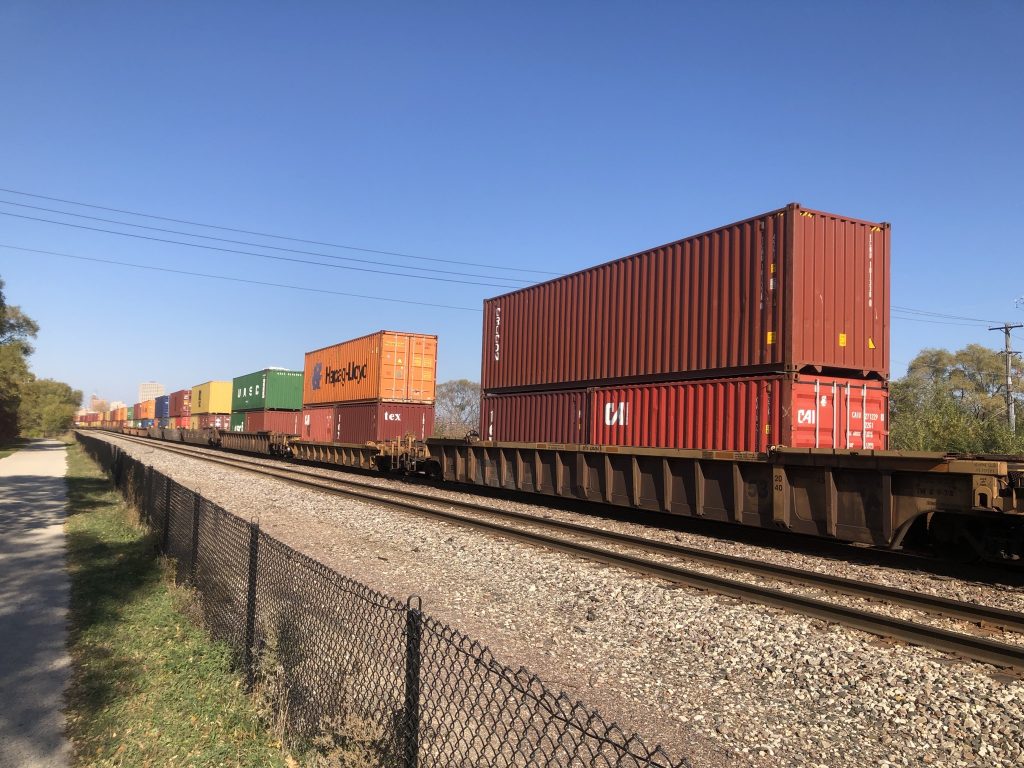New Report Details How Imports Fuel Wisconsin Factories, Hospitals
Wisconsin Policy Forum analyzes $40 billion of state imports.

Shipping containers on a Canadian Pacific train as seen from the Kinnickinnic River Trail. Photo by Jeramey Jannene.
Wisconsin customers and businesses purchased $38.9 billion worth of imported goods last year, but recent increases in U.S. tariffs have raised concerns about inflation, decreased availability of products and unintended effects to state manufacturing.
That’s according to a new report from the Wisconsin Policy Forum looking at Wisconsin’s import economy.
Since 2016, the inflation-adjusted value of the state’s imports has grown by 32.4 percent. The goods purchased from abroad range from T-shirts and furniture to industrial machinery and medical equipment.
Tyler Byrnes, the report’s author, said Wisconsin’s imports highlight just how interconnected the global economy is.
“You need an imported product to run your factory, so you can make things for exports,” Byrnes said. “Really, the import economy drives the export economy.”
Industrial and electrical machinery account for roughly one-third of Wisconsin’s total imports, with most industrial machinery being purchased by businesses in agriculture, construction and manufacturing, the report says. State businesses also import billions of dollars worth of raw materials.
The state’s health care sector also relies on imports. Wisconsin last year imported $4.7 billion worth of pharmaceutical products — both prescription and non-prescription drugs — and $2.4 billion worth of medical and scientific equipment, according to the report.
Wisconsin consumers also spent more than $3.1 billion on vehicles and parts, $1.6 billion on plastic products, $0.9 billion on furniture and bedding, and $0.8 billion on knit clothing, according to the forum.
From 2018 to 2024, the value of Wisconsin’s imports from China have fallen by 37.3 percent, according to the report. That drop can be attributed, at least in part, to U.S. tariffs imposed in 2018 against some Chinese imports, as well as a broader shift in policymakers’ views toward that country, the report states.
At the same time, some Chinese firms have shifted production to other southeast Asian countries, like Vietnam, to avoid U.S. tariffs. Since 2018, Wisconsin’s imports from Vietnam have more than doubled from $1.2 billion to $2.7 billion in 2024, according to report data.
“If you have a laptop factory that had been in China … and you do the final assembly in a country that doesn’t have tariffs, then you’re avoiding those costs,” Byrnes said. “It could be difficult to track where these goods come from.”
Behind China, Canada ranks as Wisconsin’s second largest source of imported goods, accounting for $6.3 billion last year, the study says. Some of the products that come from Canada include paper, chemicals and processed foods.
Imports from Mexico have grown dramatically since 2018, from $3.5 billion to $5.9 billion last year. Vehicles and vehicle parts are by far the largest category of state imports from Mexico, accounting for $2.4 billion in 2024.
If combined, the 27 countries that make up the European Union would be the state’s top import source, accounting for $10.2 billion last year, according to the forum.
“You were to add up Canada, Mexico and the EU, that’s the vast majority of our imports,” Byrnes said. “These are long-term trade partners.”
Even so, President Donald Trump has imposed blanket 10 percent tariffs on imports from all countries as part of a 90-day pause on higher country-specific reciprocal tariffs that are set to expire in July. The administration also announced this week it was pausing 145 percent tariffs on China for 90 days, bringing tariffs on Chinese goods down to 30 percent.
“Ten percent on goods from all over the world is much higher than we’ve had as a tariff in a long time,” Byrnes said. “Same thing with this 30 percent tariff on Chinese imported goods. It’s not 145 percent, but it’s much higher than they were in the past.”
Those tariffs could raise prices for consumers, disrupt supply chains, slow economic growth and even lead to a recession, the report states. In fact, the cost of Trump’s 2018 tariffs were passed almost entirely on to consumers, according to the report.
“There’s been a lot more economic uncertainty in May of 2025 than there was in January of 2025, so there may be impacts if the global economy sputters in response to these tariffs,” Byrnes said.
While state policymakers are limited in how they can respond to federal trade policy, Byrnes said they should be cautious in preparing the next state budget.
He said previous tax collection estimates were completed prior to the economic uncertainty caused by Trump’s tariffs, and those estimates “may not look quite as good” the next time they’re completed.
“It may be wise to kind of hold back on any massive spending or tax changes, at least until we get a better sense of what the economic outlook is going to be,” Byrnes said. “Caution in budgeting, with the understanding there may be some bad economic times ahead, might be wise.”
New report says Wisconsin imports support local manufacturing, health care industries was originally published by Wisconsin Public Radio.
If you think stories like this are important, become a member of Urban Milwaukee and help support real, independent journalism. Plus you get some cool added benefits.





















